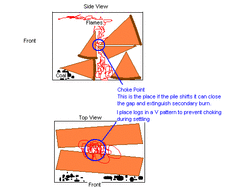Hey gang, need some input here. I have been burning overnight since 1977 but could use some words of wisdom on burning the new EPA dragon. What is your routine as far as loading, initial firing and cutting them back on primary air (I still can't bring myself to call cutting back primary air "damping down" since an ole stack damper ain't involved) for night time burns.
That is, do ya load yours a split or two at a time and establish the burn or pack it on top of the hot coals and go, do you have a set temp you take it up to and then back down the primary air and just how far back do you cut the primary before waving goodnight to your heat making buddy and going to bed.
The Jotul F3 is a no brainer. Put the few pieces of wood it will hold in it, fire crap out of it to 500 and then cut it back to 25%. In three hours, rinse and repeat. Not so the big box burner. Fire the crap out of it fully loaded with the draft I have and a chimney cap is headed for the next county.
Words of experience and wisdom cheerfully solicited. Absorbing it all and arguing with none.
That is, do ya load yours a split or two at a time and establish the burn or pack it on top of the hot coals and go, do you have a set temp you take it up to and then back down the primary air and just how far back do you cut the primary before waving goodnight to your heat making buddy and going to bed.
The Jotul F3 is a no brainer. Put the few pieces of wood it will hold in it, fire crap out of it to 500 and then cut it back to 25%. In three hours, rinse and repeat. Not so the big box burner. Fire the crap out of it fully loaded with the draft I have and a chimney cap is headed for the next county.
Words of experience and wisdom cheerfully solicited. Absorbing it all and arguing with none.



